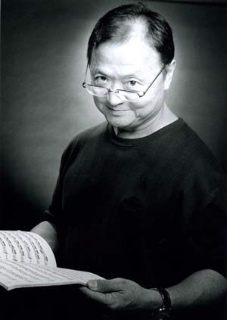Take jazz standards from his days working with the Duke Ellington Orchestra on Broadway and combine it with personal cultural influences, quotations from timeless Hollywood film scores, and an undeniable knowledge of classical composition ““ you’ve now got a concerto that lives to please a diverse audience.
UCLA’s Paul Chihara, professor of Composition for Visual Media, a program in the music department, will hold a concert on Wednesday, May 19 in Schoenberg Hall as part of the West Coast premiere of his arrangement “Dances at a Gathering.” In its allusion to the 1969 New York ballet by the same title, “Dances” emphasizes music as a form of auditory dance.
Chihara, founder and chairman of a fairly new department predicated on composing film and television scores, incorporates a great deal of his personal background as a Japanese American in his musical endeavors.
“During the Second World War, (I was) 5 years old,” Chihara said. “I, along with my family, was relocated and it was there ““ and this is kind of a blessing for me ““ where I first began to entertain. Every Saturday, in the canteen where we ate and gathered, I would perform and sing popular songs of the era. So I began show business when I was about 5 years old, bringing music to people who need and love it.”
After earning his graduate degree in music with a minor in English literature from Cornell University, Chihara went on to pursue work at major film studios such as Walt Disney and Warner Bros. It was during this time that he met Jerry Goldsmith, famous Hollywood composer, friend and colleague.
“He and I were hired by UCLA several years earlier to design and guide the brand new film music program, which is now called Visual Media,” Chihara said. “He was one of the greatest composers in Hollywood history and a very good friend. The principal melody in the second movement of “˜Dances at a Gathering’ is my homage to him, and two of his “˜Asian’ themes are played in counterpoint with it: from the memorable movies “˜Chinatown’ and “˜The Sand Pebbles.'”
The presence of such identifiable, Hollywood references in a seemingly reserved, “high-brow” form of music attracts Bruins who may not have tracks by Bach and Mozart on their iTunes “Recently Purchased” playlist.
“The film score to “˜Chinatown’ is one of the most memorable visual accompaniments for me personally,” said Anna Mason, a third-year American literature student. “I’m interested to hear how this composer incorporates the theme in his piece.”
The concerto itself is composed of three movements. The first is played at a fast tempo, which slows down notably in the second movement, and regains speed for the third and final section. This composition stands out for its juxtaposition of woodwinds, heavy brass instruments and strings ““ all competing for the audience’s attention.
“In this piece you have two string players that are struggling to be heard, which is difficult to do volume-wise with the presence of both brass and woodwind,” said UCLA music professor and concert cellist Antonio Lysy.
“So what we have to do, as string players, is make our music so interesting and compelling to somehow make the conductor and musicians really want to listen to what we have to say.”
Lysy, who has been playing the cello for nearly forty years, will perform alongside his colleague, violinist and music Professor Guillaume Sutre, The two will be accompanied by the UCLA Wind Ensemble and conducted by Professor Thomas Lee. This assembly of Bruin talent can undoubtedly do justice to the free flowing, absorbing sounds evoked in Chihara’s work.
“Paul Chihara is a giant in this field, and he’s one of UCLA’s most eminent professors. He’s composed music that’s been performed all over the world,” Lysy said. “This piece has a sort of influence that could be close to 12-tone and Schoenberg, while on the other hand, you hear something that’s very close to film music: very tonal, lyrical and luscious.”
Whether it be your interest in Goldsmith, your affinity for music that can flow and dance, or the fact that he can serve everything in a classically structured package, “Dances at a Gathering” is sure to entertain and gratify even the most estranged music fan.
“I don’t think that anybody will have any problem understanding this music at all,” Chihara said. “When you’re entertaining, you’re not being academic. You want people to enjoy themselves and to love you. And this piece wants to do that too ““ it wants to touch people.”
